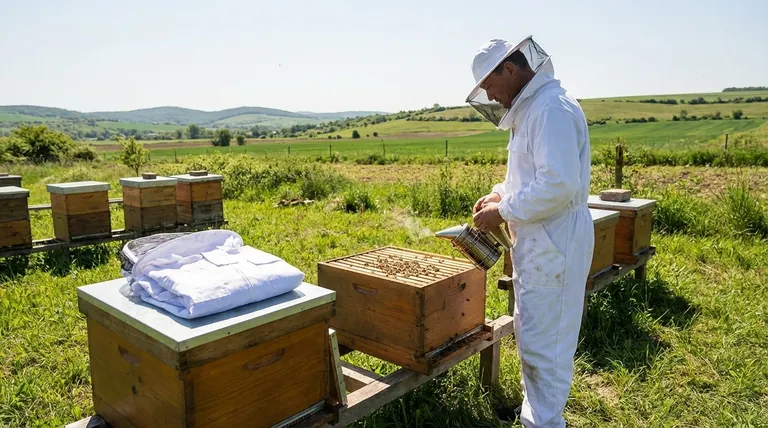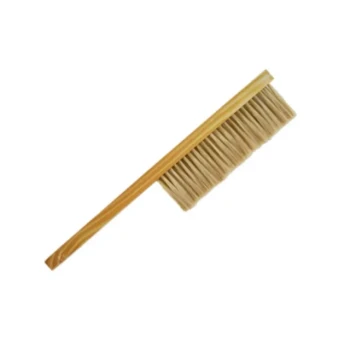In short, a spare beekeeping suit is recommended for redundancy. It ensures that if your primary suit is damaged, contaminated, or otherwise compromised during a hive inspection, you have an immediate backup to continue your work safely and without interruption.
The need for a spare suit isn't about owning more gear; it's about maintaining an unbroken state of protection. A tear, a broken zipper, or heavy contamination can instantly render a suit useless, and a backup is the only thing that prevents a minor inconvenience from becoming a major safety risk or a halted workday.

The Core Principle: Uninterrupted Protection
The primary purpose of any bee suit is to create a reliable barrier between you and the bees. Having a spare is a risk management strategy that ensures this barrier is always available.
Preventing Work Stoppages
A tear or rip in your suit means you must stop what you are doing immediately. Continuing to work with a compromised suit is an unnecessary risk. A spare allows you to quickly change and safely complete your inspection or hive management task.
Mitigating the Risk of Stings
Even gentle colonies can become defensive. A damaged suit has gaps that bees can and will exploit. For novice beekeepers especially, the confidence that comes from full-body protection is critical for working calmly and effectively. A spare ensures that confidence is never compromised.
Managing Contamination
A suit can become compromised without being torn. If a suit is covered in venom from multiple stings, the alarm pheromone can agitate the colony further. Swapping to a clean, spare suit can help de-escalate the bees' defensive response. Likewise, getting covered in honey or propolis can make a suit sticky and difficult to work in.
Common Pitfalls and Suit Failures
A bee suit is a tool, and like any tool, it can fail. Understanding these failure points clarifies why a backup is so essential.
Physical Tears and Punctures
Catching your suit on a sharp corner of a hive box, a branch, or a piece of equipment is a common occurrence. While high-quality suits are durable, no fabric is indestructible.
Zipper and Veil Failure
Zippers are a frequent point of failure. A broken zipper, especially around the veil, creates a significant gap for bees to enter. Similarly, a small hole in the veil mesh can be difficult to see but makes the entire suit unsafe.
Poor Fit Leading to Gaps
A suit that is too tight can pull fabric taut against your skin, making it easier for a bee's stinger to reach you. A suit that is too loose can snag easily. A poor fit can also create gaps at the wrist, ankles, or neck, compromising protection. This is why investing in a primary suit with a proper, adjustable fit is critical.
Understanding the Alternatives
Your "spare" does not necessarily need to be an identical full suit. Your beekeeping style and the types of tasks you perform should inform your strategy.
The Case for a Full Suit
A full, one-piece suit offers maximum protection. It ensures there are no gaps at the waist for bees to access, which is a common issue with separate jackets and pants. This is often the best choice for beginners or for complex tasks like hive relocations.
The Practicality of a Jacket
A beekeeping jacket is lighter, cooler, and easier to put on for quick inspections in hot weather. For an experienced beekeeper working with a calm colony, a jacket may be sufficient for most routine checks. A jacket can serve as an excellent "spare" for a full suit, reserved for these less intensive tasks.
Defining Your Protective Equipment Strategy
Your approach to protective gear should be tailored to your specific context and goals.
- If your primary focus is maximum safety as a new beekeeper: Invest in two high-quality, full bee suits so you always have a reliable backup.
- If your primary focus is efficiency for frequent, quick checks: Your primary could be a full suit, with a durable bee jacket serving as your spare and your go-to for hot days.
- If your primary focus is managing multiple hives: A spare suit is a non-negotiable part of your professional toolkit to ensure operational continuity.
A thoughtful strategy for your protective equipment is the foundation of safe, confident, and effective beekeeping.
Summary Table:
| Scenario | Risk Without a Spare Suit | Benefit of Having a Spare |
|---|---|---|
| Tear or Puncture | Immediate work stoppage; safety risk | Quick change to continue work safely |
| Zipper or Veil Failure | Major gap for bee entry; unsafe to proceed | Backup suit ensures complete protection |
| Contamination (pheromones/honey) | Agitated bees; sticky, difficult work | Clean suit de-escalates bees and improves comfort |
| Poor Fit (gaps/snags) | Increased risk of stings; compromised confidence | Properly fitting spare maintains protection and confidence |
Don't let a suit failure halt your beekeeping operations. For commercial apiaries and distributors, uninterrupted productivity is key. HONESTBEE supplies durable, high-quality beekeeping suits and equipment designed for professional use. Ensure your team is always protected and your work continues without interruption. Contact HONESTBEE today to discuss your wholesale needs and build a reliable protective gear strategy.
Visual Guide

Related Products
- Cotton Beekeeping Suit and Round Hat with Veil Bee Keeper Protective Gear
- White Beekeeping Protective Suit and Hat with Fencing Veil for Beekeepers
- Heavy Duty Cowboy Beekeeper Hat with Visibility Veil Outdoor Professional Beekeeping Protective Gear
- Beekeeper Cowboy Hat and Veil for Beekeeping
- Professional Beekeeping Suit for Kids and Girls Childrens Bee Keeper Suit
People Also Ask
- What should be considered regarding the color of beekeeping clothing? Ensure Your Safety and Keep Bees Calm
- Do beekeeping suits completely prevent stings? Maximize Your Apiary Safety with the Right Gear
- How should a bee suit be cleaned? Protect Your Investment and Ensure Apiary Safety
- What factors should be considered when choosing a beekeeping suit? Balance Safety, Comfort & Performance
- Why is white the predominant color in bee suit designs? | Key to Hive Calm & Beekeeper Safety



















